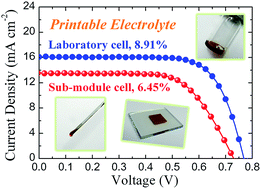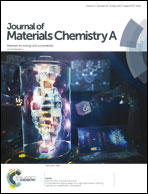High-performance printable electrolytes for dye-sensitized solar cells
Abstract
High-performance quasi-solid-state electrolytes with printable characteristics are developed herein for dye-sensitized solar cells (DSSCs). The printable electrolytes are prepared based on a 3-methoxypropionitrile liquid electrolyte containing I−/I3− redox couples. Poly(ethylene oxide) (PEO) and poly(vinylidene fluoride) (PVDF) are utilized as agents to regulate the viscosity and properties of the electrolyte pastes; furthermore, TiO2 nanoparticles are used as a filler to enhance the performance of the electrolytes. The results show that PEO is a required material to prepare the electrolyte pastes for operation by a printing process. However, if only PEO is utilized, the conversion efficiency of the corresponding cell (7.65%) is much lower than that of the liquid one (8.34%). By introducing PVDF as a co-regulating agent, the resultant cell can achieve an efficiency of 8.32% similar to that of the liquid cell, mainly attributed to the decrease of charge transfer resistance at the electrolyte/Pt counter electrode interface. In addition, if 4 wt% TiO2 nanoparticles are introduced as fillers into the printable electrolyte, the cell efficiency can be further increased to 8.91%. By applying this printable electrolyte to a sub-module cell, a conversion efficiency of 6.45% is achieved. The DSSCs prepared by the printing process are stable under a long-term stability test at 60 °C.



 Please wait while we load your content...
Please wait while we load your content...